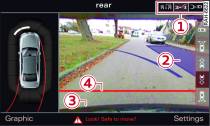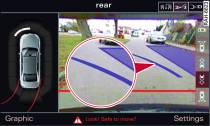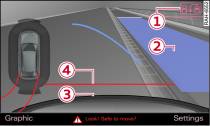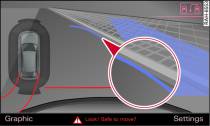-

- Fig. 1 Display: Blue area marking aligned in parking space
-

- Fig. 2 Display: Blue marking touches edge of pavement
-

- Fig. 3 Display: Blue area marking aligned in parking space
-

- Fig. 4 Display: Blue marking touches edge of pavement
Applies to vehicles: with parking system with surround view cameras
This view can be used when parking your vehicle at the roadside.
The section below describes how to park on the right side of the
road. The procedure for parking on the left is similar.
The following steps apply only when there are no obstacles (such
as a wall) next to the parking space. Otherwise, please follow the
"Instructions for parking next to obstacles"
Link.
Operate the turn signal.
Position your car beside a parked vehicle in front of the space
where you want to park. The distance from the vehicle should be
about 1 metre.
Switch on the MMI and select reverse gear. The parking aid will
be switched on and the perpendicular
parking view will be displayed.
Press control button -1-
Fig. 3 on the
MMI control console. The parallel parking
view will be displayed.
Reverse and align your vehicle in such a way that the blue area
marking -2- borders onto the vehicle behind or onto the parking
space line marking
WARNING!,
Caution!. The blue marking is an extension of the vehicle outline
and reaches about five metres to the rear of the vehicle. The long
side of the blue marking should border onto the kerb. The complete
blue area marking must fit into the parking space.
When the vehicle is stationary turn the steering wheel to the right
as far as it will go.
Reverse into the parking space until the blue curve
Fig. 4 touches
the kerb
WARNING!,
Caution!. Stop the vehicle.
When the vehicle is stationary turn the steering wheel to the left
as far as it will go.
Parking next to obstacles
If an obstacle (such as a wall) is located next to the parking
space, the clearance at the side of the vehicle must be larger.
Position the long side of the blue marking so that there is
sufficient clearance from the kerb. The marking must not touch
the kerb. You must also start turning the steering wheel much
earlier. The blue curve
Fig. 4 must
not touch the kerb - make
sure there is sufficient clearance from the kerb.
Note
The orientation lines and markings appear on the left or right side,
depending on which turn signals are on.
